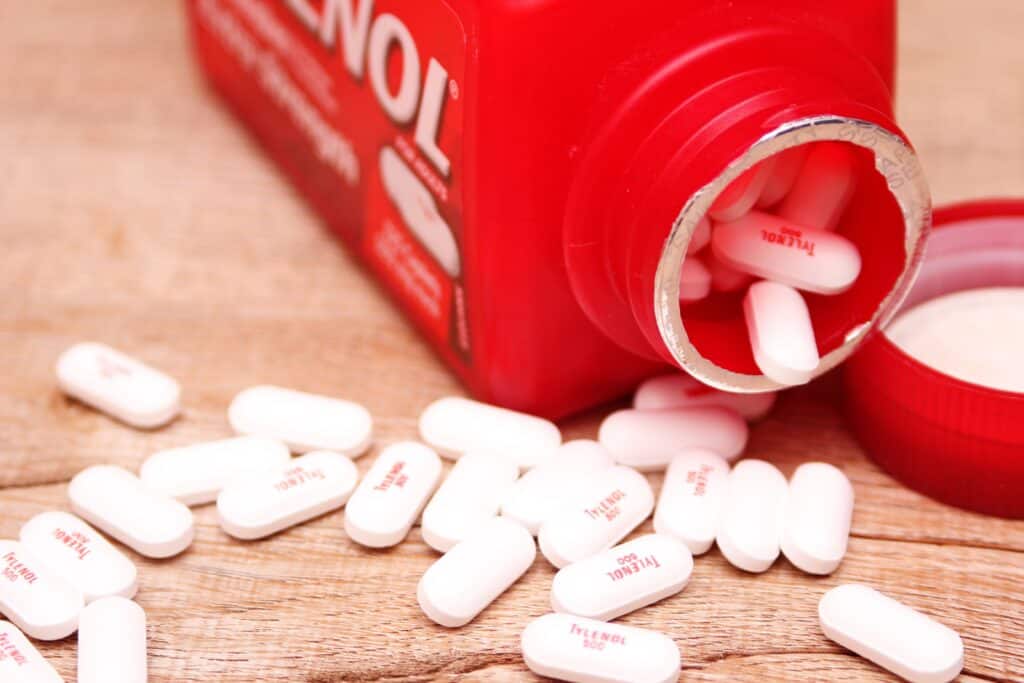
Acetaminophen, commonly known as Tylenol, is one of the most widely used over-the-counter medications for pain relief and fever reduction. It is found in a wide range of prescription and non-prescription medications. The recommended maximum daily dose for adults is typically 4,000 milligrams, but this limit can vary based on individual health conditions and other factors.
For infants and children under 12 years old: 10-15 mg per kilogram of body weight every 4 to 6 hours, at most five doses in 24 hours. The maximum daily dose should not exceed 75 mg per kilogram of body weight or 4,000 mg (whichever is lower) in 24 hours.
Despite its popularity and general safety when used as directed, acetaminophen is also associated with a significant risk of toxicity, particularly in cases of overdose. You may be surprised to learn that acetaminophen is the most common reason for liver failure requiring transplant in the US.
The primary mechanism of acetaminophen toxicity involves its metabolism in the liver. Normally, acetaminophen is metabolized via conjugation with sulfate and glucuronide, with a small fraction oxidized by cytochrome P450 enzymes to form N-acetyl-p-benzoquinone imine (NAPQI), a highly reactive and toxic metabolite. Under normal conditions, NAPQI is detoxified by conjugation with glutathione; however, in cases of overdose, the conjugation pathways become saturated, leading to an accumulation of NAPQI, which then causes oxidative damage to liver cells and potentially results in acute liver failure.
Acetaminophen leads to 56,000 emergency visits, 2,600 hospitalizations, and 500 deaths annually in the United States, with half of these incidents being unintentional overdoses. I am not surprised by these statistics, as I have seen many cases of acetaminophen poisoning, both intentional and unintentional.
Unintentional overdoses occur when individuals inadvertently consume more acetaminophen than the recommended dose. Children are particularly at risk for unintentional overdoses, with accidental ingestion being a leading cause of pediatric poisonings.
Several factors contribute to the high incidence of unintentional acetaminophen overdoses:
Polypharmacy: Many individuals take multiple medications concurrently without realizing that several of these may contain acetaminophen. This is common in over-the-counter remedies for colds, flu, and pain management.
Lack of Awareness: There is often a lack of awareness about the recommended maximum daily dose of acetaminophen. Patients may assume that over-the-counter medications are inherently safe, leading them to exceed the safe dosage.
Miscommunication: Miscommunication between healthcare providers and patients regarding the safe use of acetaminophen can lead to unintentional overdoses. This is particularly problematic in populations with limited health literacy or language barriers.
Dosing Errors: Mistakes in dosing, especially in pediatric populations where liquid formulations are common, can result in significant overdoses. Caregivers may misinterpret dosing instructions or use inappropriate measuring devices.
Chronic Pain Management: Individuals with chronic pain conditions may exceed the recommended dosage in an attempt to manage their pain more effectively, not realizing the potential for toxicity. The truth is that exceeding the recommended dose does not make the pain any better, but rather just increases risk for liver damage.
Concerning intentional overdose, it is also notable that acetaminophen is one of the most common substances involved in overdose-related suicides.
The symptoms of acetaminophen overdose can be divided into four stages, each with distinct clinical features:
Stage I (0-24 hours): Symptoms during the first 24 hours are often nonspecific and may include nausea, vomiting, anorexia, malaise, and pallor. Some individuals may not exhibit any symptoms at all during this stage.
Stage II (24-72 hours): As the liver becomes more affected, patients may experience right upper quadrant abdominal pain, increased liver enzymes (AST and ALT), and elevated bilirubin levels. Laboratory tests may reveal a prolonged prothrombin time and hypoglycemia.
Stage III (72-96 hours): This stage is characterized by the peak of liver injury, with symptoms including jaundice, coagulopathy, hepatic encephalopathy, and multi-organ failure. If untreated, this stage can lead to death.
Stage IV (4 days to 2 weeks): For those who survive the critical phase, this stage involves recovery, which may be complete or partial, depending on the extent of liver damage.
The treatment of acetaminophen overdose is time-sensitive and involves several key steps:
Activated Charcoal: If the patient presents within 1-2 hours of ingestion, activated charcoal can be administered to reduce the absorption of acetaminophen from the gastrointestinal tract.
N-Acetylcysteine (NAC): NAC is the antidote for acetaminophen toxicity. It acts by replenishing glutathione stores, enhancing the conjugation and elimination of NAPQI. NAC is most effective when administered within 8-10 hours of ingestion but can still provide benefits even if given later. NAC is usually given IV as it tastes horrible and it is difficult to get patients to drink it.
Supportive Care: In severe cases, supportive care in an intensive care unit may be necessary. This can include monitoring and managing complications such as hepatic encephalopathy, coagulopathy, and renal failure.
Liver Transplantation: In cases of fulminant hepatic failure where the patient does not respond to medical treatment, liver transplantation may be the only viable option to save the patient’s life.
Acetaminophen is a widely used and generally safe medication when used appropriately. However, it certainly has the potential for toxicity if taken above the recommended dose. It is a good reminder that in pharmacology, more is not necessarily better – it can be deadly.
Sources and More Information
Agrawal S, Khazaeni B.acetaminophen Toxicity. [Updated 2023 Jun 9]. In: StatPearls [Internet]. Treasure Island (FL): StatPearls Publishing; 2024 Jan-. Available from: https://www.ncbi.nlm.nih.gov/books/NBK441917/.
Mazaleuskaya LL, Sangkuhl K, Thorn CF, FitzGerald GA, Altman RB, Klein TE. PharmGKB summary: pathways of acetaminophen metabolism at the therapeutic versus toxic doses. Pharmacogenet Genomics. 2015 Aug;25(8):416-26. doi: 10.1097/FPC.0000000000000150. PMID: 26049587; PMCID: PMC4498995.


